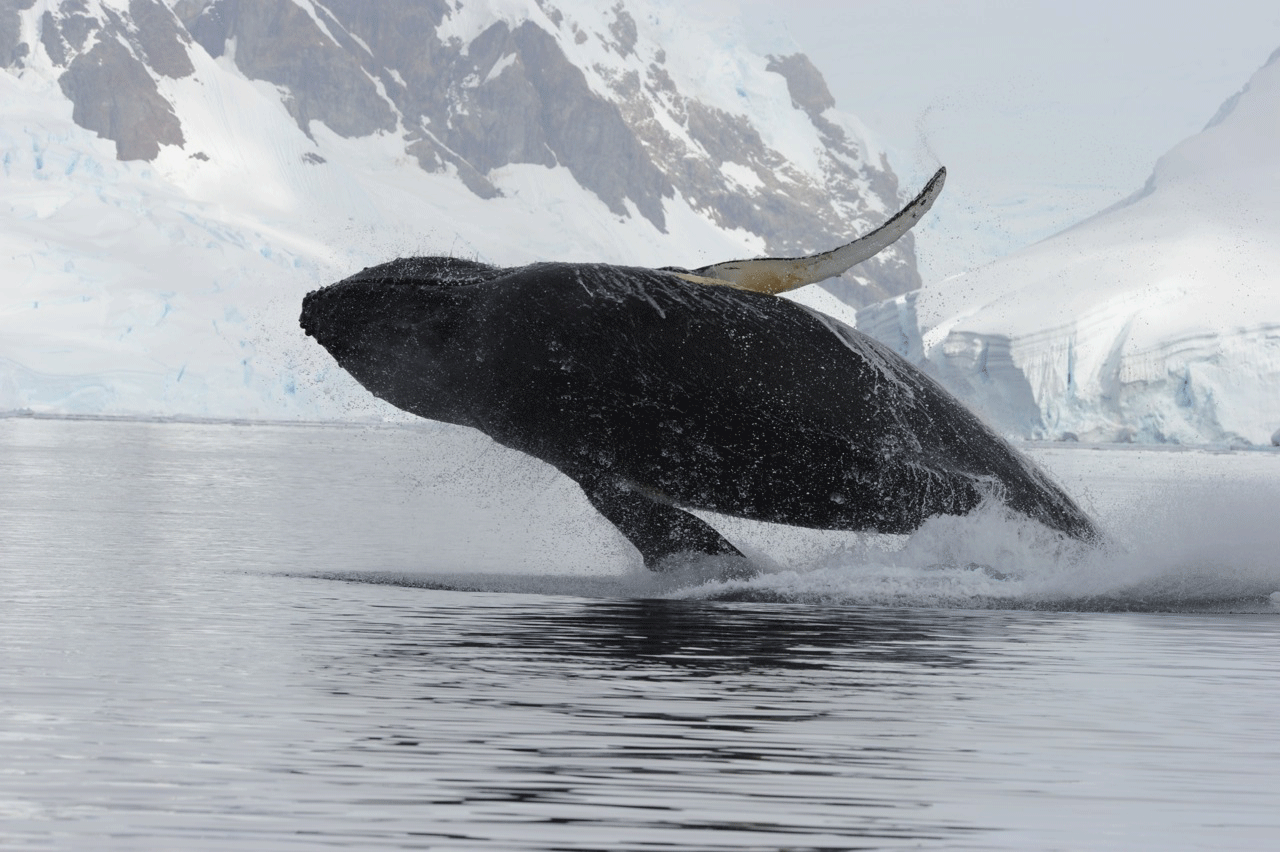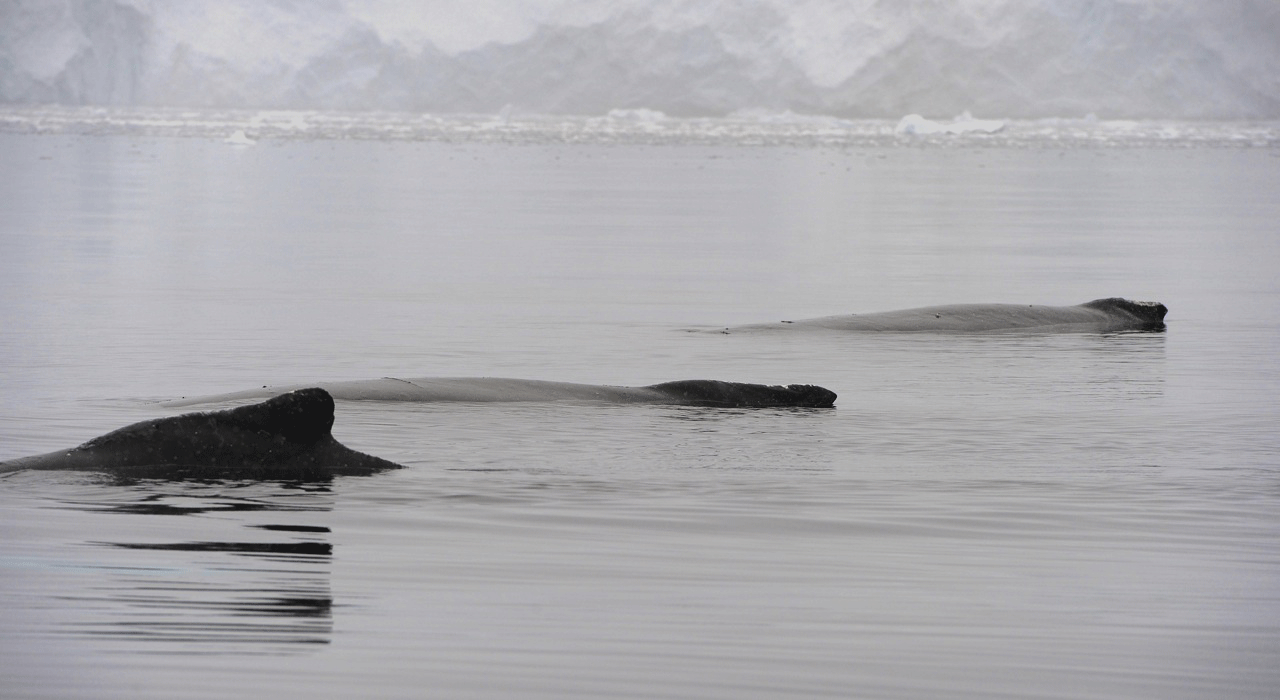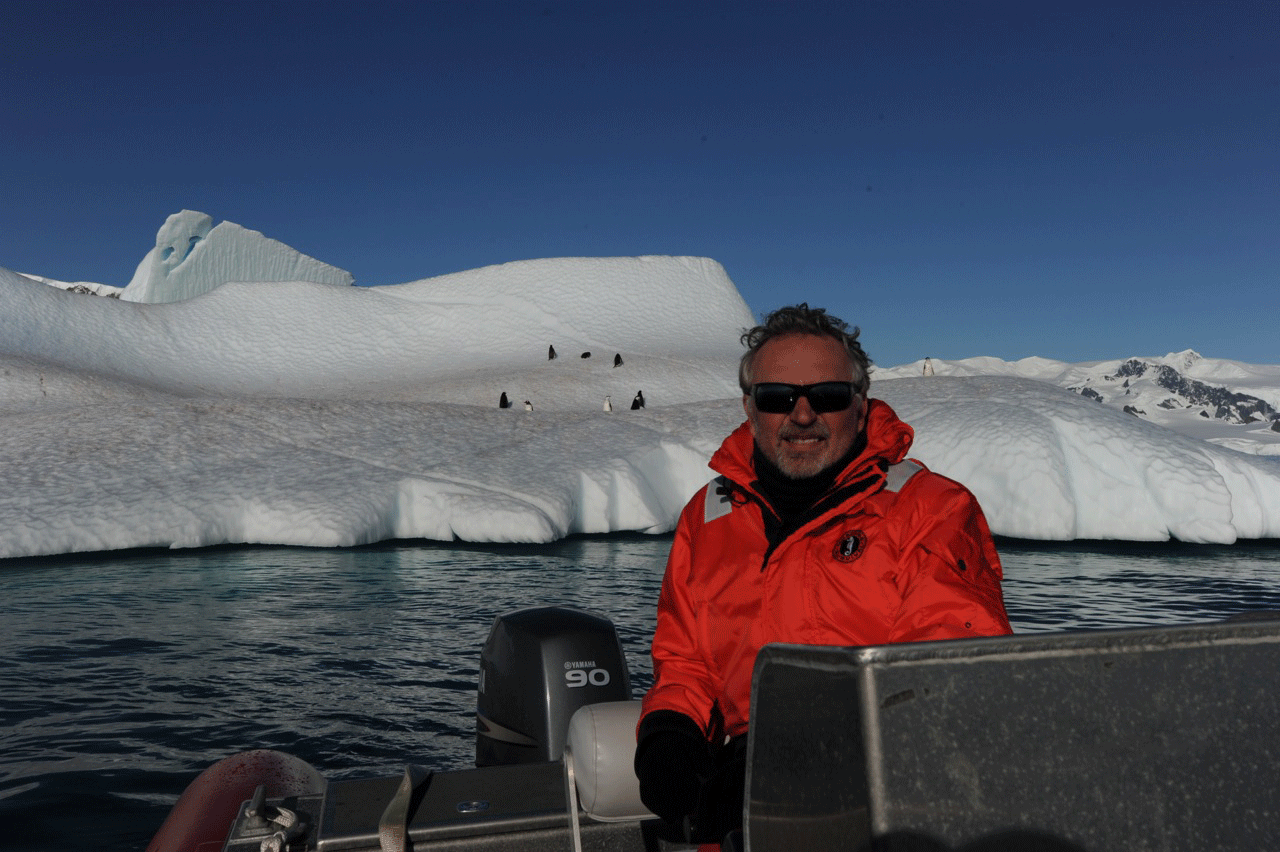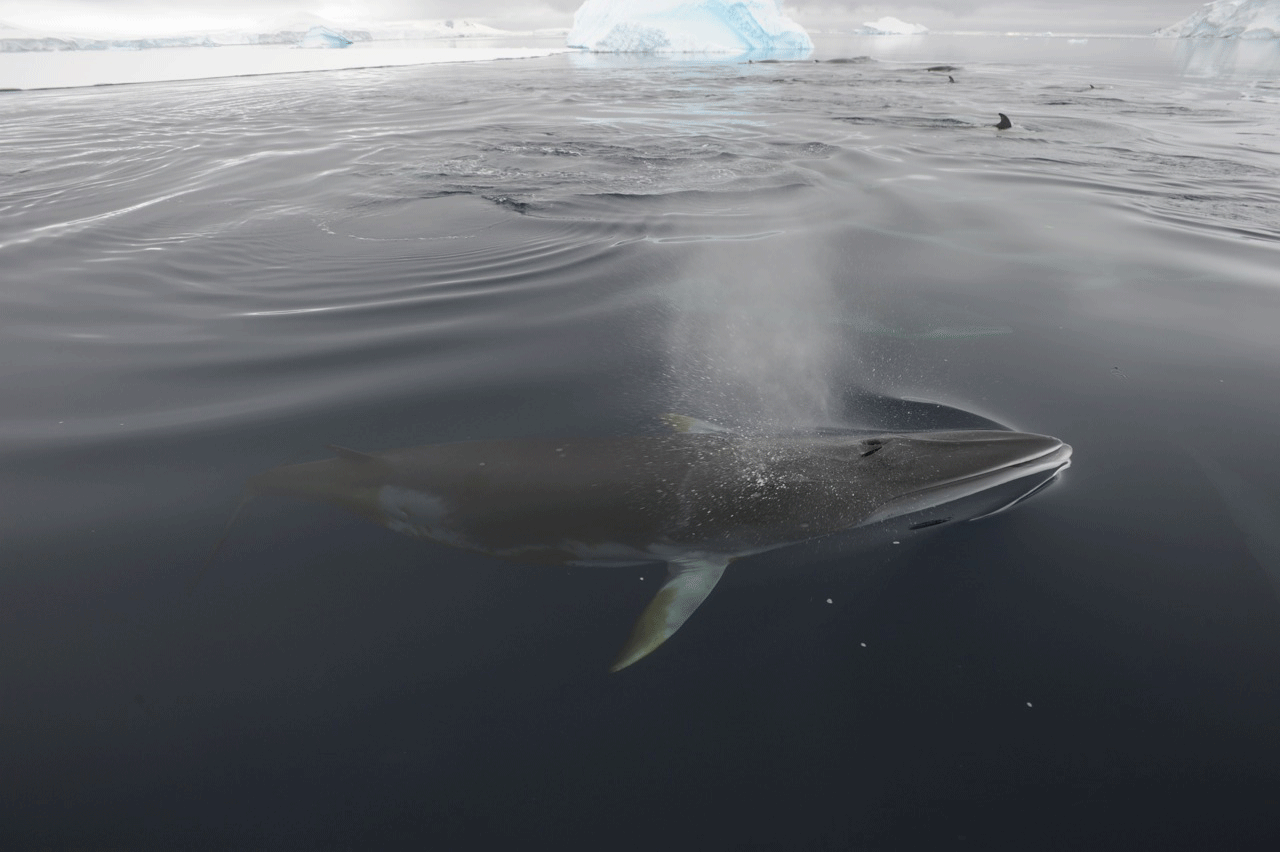International Court Saves Whales
Air Date: Week of April 4, 2014

Humpback whale breaching in Wilhelmina Bay, Western Antarctic Peninsula. (photo: Dr. Ari Friedlaender, Oregon State University.)
Japan has been hunting whales under the guise of science since a ban nearly thirty years ago. Now Duke university marine biologist Andy Read tells host Steve Curwood that a new ruling from the International Court of Justice could put an end to Japanese whaling.
Transcript
CURWOOD: From the Jennifer and Ted Stanley Studios in Boston and PRI, this is Living on Earth. I’m Steve Curwood. There is good news this week for whales, especially those in the seas off Antarctica. The International Court of Justice has ordered Japan to stop what it found to be commercial whaling under the guise of scientific research. Though Japan signed on to the International Whaling Commission ban nearly thirty years ago, it kept on hunting. In 2010 Australia filed charges at the International Court, alleging Japan was in gross violation of the ban. For some analysis we called up Andy Read, Professor of Marine Biology at Duke University. He’s a former member of the science committee of the International Whaling Commission, and joins us now from North Carolina. Welcome to Living on Earth, Andy.
READ: It's my pleasure, thanks for having me.
CURWOOD: So what do you make of this news, the court decision? How big of a deal is this?
READ: It’s a pretty important decision. It’s a very clear ruling from the International Court that Japan has to cease and desist its Antarctic whaling program. Those of us have who have been involved in this issue for a long time were looking for clarity from the court, and we got it. It will stop immediately, any research whaling the Japanese government had anticipating conducting, and it leaves open a lot of questions what Japan will do. They have, in the past, threatened to leave the International Whaling Commission and to operate outside it. Whether or not they choose to do so, we’ll find out in the coming months and perhaps years. But it’s a clear and decisive step forward in terms of the management of whales in the Antarctic.
CURWOOD: So give us a little history lesson here, Professor. How were the Japanese able to continue whaling after the 1986 whaling ban went into effect?
READ: There are two routes to continue whaling. One is to file an objection to the moratorium, as you indicated it came into place, 1985, 1986. And several countries filed objections to that change, including Iceland and Norway, which continue to hunt whales commercially today. Japan withdrew its objection to that change under US pressure, and so was no longer about to engage in commercial whaling. But there is a provision within the convention that allows countries who are members of the International Whaling Commission to kill whales for the purposes of scientific research. The term ‘scientific research’ is not ever defined in the convention itself, but Japan engaged in a very large-scale, two large-scale projects actually, one of in the north Pacific and one in the Antarctic in which they killed more than 10,000 whales over the last couple of decades. The killing of those whales, was, according to the government of Japan, for the purposes of scientific research, but the meat that was generated from killing those whales was sold on the market in Japan. And so many of us, many independent observers, have argued that this is commercial whaling under the guise of science rather than a true scientific research program, and the court agreed with us in its decision.

Antarctic minke whale in Wilhelmina Bay, Western Antarctic Peninsula. Researchers use the notches in the trailing edge of the dorsal fin to identify the whale and to track it’s movements over time using photographic identification techniques. (photo: Dr. Ari Friedlaender, Oregon State University.)
CURWOOD: Now this ruling only applies to the Southern Ocean. What about Japanese whaling in the northern Pacific?
READ: Right. You’re correct, the ruling does not apply to the north Pacific. I think most of us believe that the precedent is strong enough that Japan will also stop its north Pacific program, but that’s not what the legal case says, so it’s possible that Japan will continue to take whales, especially permit catches in the north Pacific, although it seems unlikely to me they’d continue to do that.
CURWOOD: Now, what were the kinds of whales the Japanese where hunting?
READ: Three species of whales were listed under the Japanese Antarctic research program. Mostly Minke whales, the quota of Minke whales, the smallest of the baleen whales taken was about 850 a year. There were two other species, larger species, Fin whales and Humpback whales, and those three species were all listed under the program, although only Minke whales and Fin whales were taken. Japan never actually killed any Humpback whales as part of its research program.
CURWOOD: Now, what about Norway and Iceland where whaling is still practiced? How do those countries compare to Japan in terms of their whaling haul.

Trio of humpback whales resting at the surface in Wilhelmina Bay, Western Antarctic Peninsula. (photo: Dr. Ari Friedlaender, Oregon State University.)
READ: The numbers of whales taken by both Norway and Iceland are smaller than the number of whales taken by the Japanese programs. They’ve focused mostly on Minke whales, the smallest baleen whale, and the species for which the meat is most highly prized. But it’s possible those numbers could increase if Norway and Iceland decide to try and fill the Japanese market with products from their hunts.
CURWOOD: What kind of legal pressure if any does this put on Norway and Iceland to get out of the whaling business as well?
READ: None really. They have a legal right to conduct whaling under the convention. They filed objections to the moratorium when it came into place in 1985, 1986. And so their legal position is clear. And unless they decide, as a matter of either domestic pressure or international pressure to stop whaling, they can continue to harvest whales commercially.
CURWOOD: What other potential ripple effects are there here from this decision?
READ: We know that the Convention for the Regulation of Whaling only pertains to the great whales - to the large baleen whales and sperm whales, and one or two others. The smaller cetaceans, the dolphins and porpoises, are not covered. And we know when the moratorium first came into place in 1985, 1986, the numbers of those animals, the smaller dolphins and porpoises taken in Japanese fisheries went up considerably. So it’s possible that we’ll see an increase in the numbers of those animals harvested, both in the harpoon fishery and the drive fishery. The drive fishery is the fishery that was portrayed in the movie The Cove. And there’s considerable conservation concern about the status of dolphins and porpoises taken in those fisheries, so that could be an adverse consequence of the ruling.
CURWOOD: So, Andy, in general, how are whales doing around the world these days?

Andy Read, hard at work in the Antarctic (photo: Dr. Ari Friedlaender, Oregon State University.)
READ: It depends on the species, and it depends on the population. Many populations of whales are recovering from past overharvest, past uncontrolled harvest. So in the Southern Ocean we’re seeing populations of Blue whales and Humpback whales recovering rapidly, although they’re still very small compared to what they were before the harvest started. Other whale populations are not doing so well. North Atlantic and North Pacific Right whales are still tiny populations, maybe 50 north Pacific Right whales and perhaps 500 North Atlantic Right whales. But overall, one would say the populations of whales are doing reasonably well. They're recovering where they're provided adequate protection, and we are hoping that the court decision will be one more step in the recovery of whale populations in the Southern Ocean and elsewhere in the world's oceans.
CURWOOD: Andy Read is a Professor of Marine Biology at Duke University. Thanks so much for taking the time today, Professor.
READ: It's been my pleasure.

Minke whale coming up for air in Wilhelmina Bay, Western Antarctic Peninsula (photo: Dr. Ari Friedlaender, Oregon State University.)
Links
Living on Earth wants to hear from you!
Living on Earth
62 Calef Highway, Suite 212
Lee, NH 03861
Telephone: 617-287-4121
E-mail: comments@loe.org
Newsletter [Click here]
Donate to Living on Earth!
Living on Earth is an independent media program and relies entirely on contributions from listeners and institutions supporting public service. Please donate now to preserve an independent environmental voice.
NewsletterLiving on Earth offers a weekly delivery of the show's rundown to your mailbox. Sign up for our newsletter today!
 Sailors For The Sea: Be the change you want to sea.
Sailors For The Sea: Be the change you want to sea.
 The Grantham Foundation for the Protection of the Environment: Committed to protecting and improving the health of the global environment.
The Grantham Foundation for the Protection of the Environment: Committed to protecting and improving the health of the global environment.
 Contribute to Living on Earth and receive, as our gift to you, an archival print of one of Mark Seth Lender's extraordinary wildlife photographs. Follow the link to see Mark's current collection of photographs.
Contribute to Living on Earth and receive, as our gift to you, an archival print of one of Mark Seth Lender's extraordinary wildlife photographs. Follow the link to see Mark's current collection of photographs.
 Buy a signed copy of Mark Seth Lender's book Smeagull the Seagull & support Living on Earth
Buy a signed copy of Mark Seth Lender's book Smeagull the Seagull & support Living on Earth

